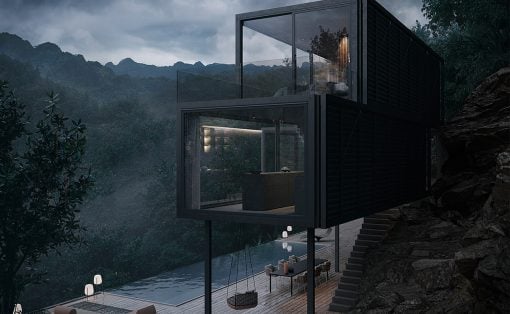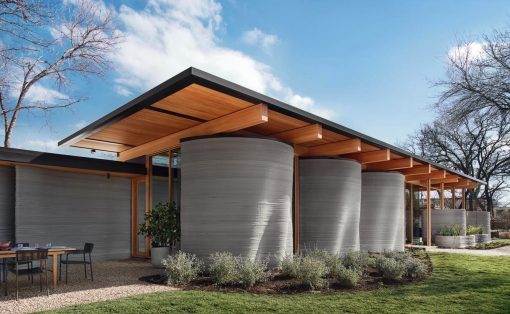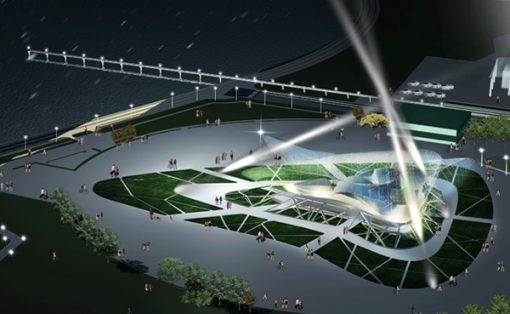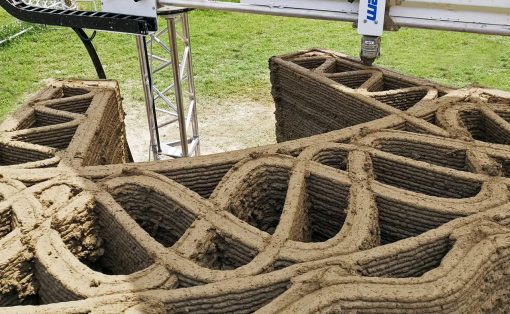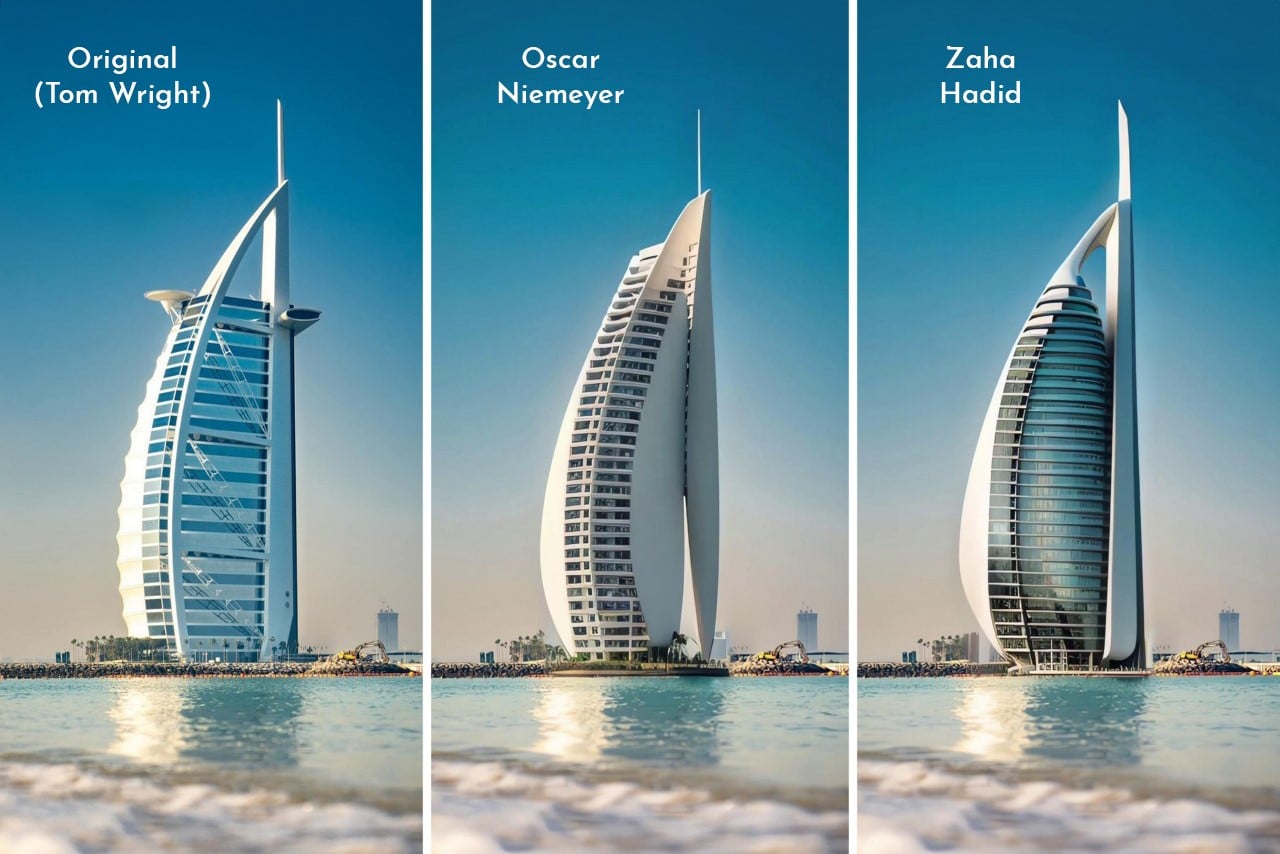
Before its younger (and taller) sibling stole its thunder, the Burj Al Arab was the jewel of Dubai’s skyline. Sitting on its own private island right beside the Palm Jumeirah, the Burj Al Arab is recognizable by its unique ship-inspired design. The design directly borrows from the sail seen on J-class yachts, standing at a staggering 321 meters tall (that’s just 60m shorter than the Empire State Building in New York). Completed in 1999, the seven-star hotel was designed by Tom Wright of WS Atkins, boasting the world’s tallest atrium which occupies more than half of the building’s height.
As iconic as the Burj Al Arab is, it’s worth wondering what it would look like if designed by other legendary architects. This collection, put together by Imagined Architecture, shows what the boat-shaped hotel would look like in the vision of 10 of the greatest architects of our time. Ranging from the unique Art Noveau styles of Gaudi to the cutting-edge aesthetic of Bjarke Ingels, this collection transforms the Burj Al Arab into a veritable catalog of global architecture movements across a span of roughly 100 years!
Image Credits: Imagined Architecture
1. Frank Gehry
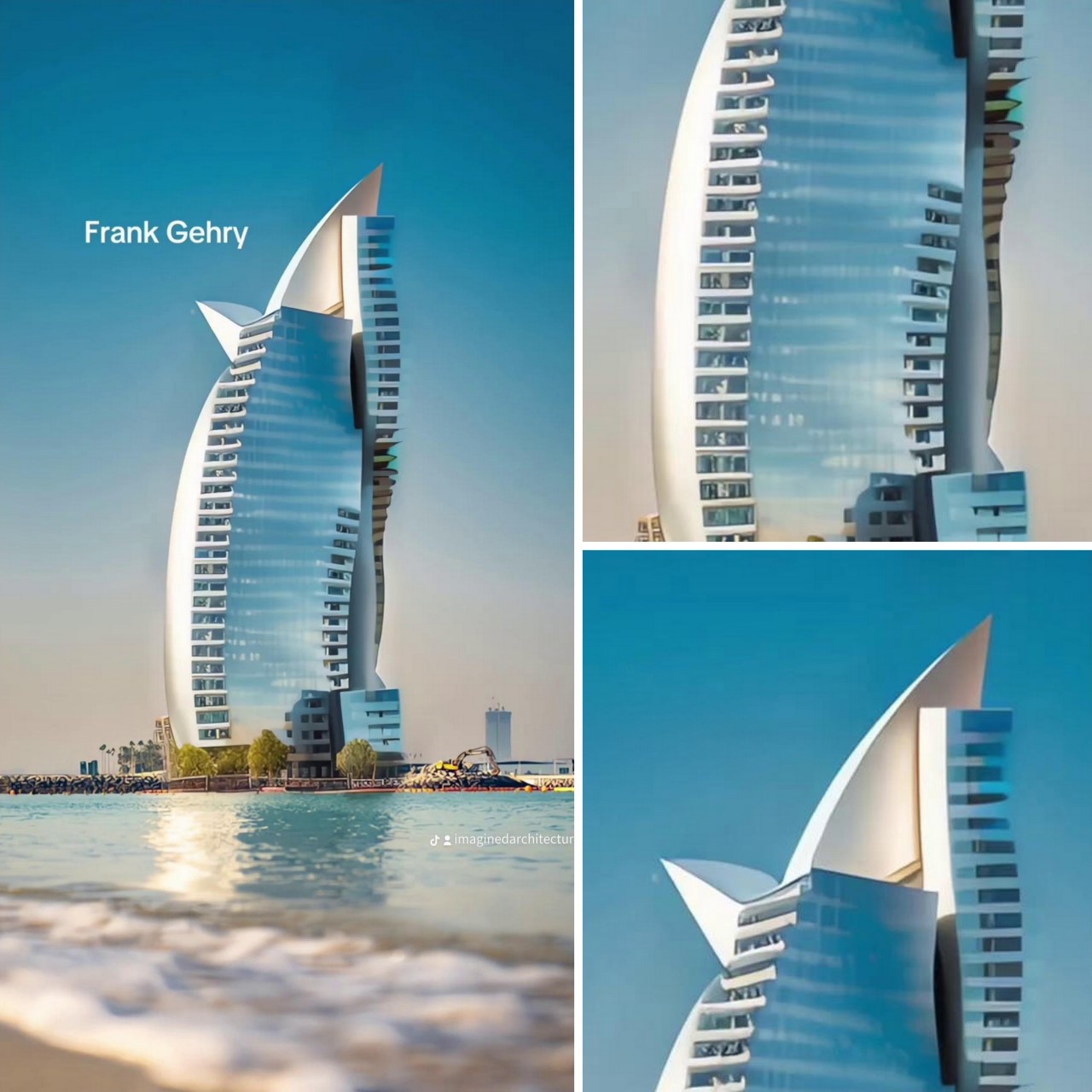
A titan of contemporary architecture, Frank Gehry is lauded for his avant-garde approach that challenges the very fabric of architectural norms. His work is often associated with deconstructivism, characterized by a sculptural technique that involves fragmented and dynamic forms. Gehry’s masterpieces, such as the Guggenheim Museum Bilbao, often feature undulating shapes and use unconventional materials that give his structures an almost animate presence.
In this reimagined Burj Al Arab, one can observe the echoes of Gehry’s distinctive style. The building retains its original, sail-like silhouette but is infused with Gehry’s signature element of movement. The facade seems to undulate with a life of its own, giving the impression of a fabric caught in a gentle sea breeze. The asymmetric windows and the disjointed placement of structural elements offer a sense of controlled chaos, a hallmark of Gehry’s design ethos. There’s also a playful use of form in the balconies and the building’s apex that adds to the whimsical, yet sophisticated character typical of a Gehry design.
2. Zaha Hadid
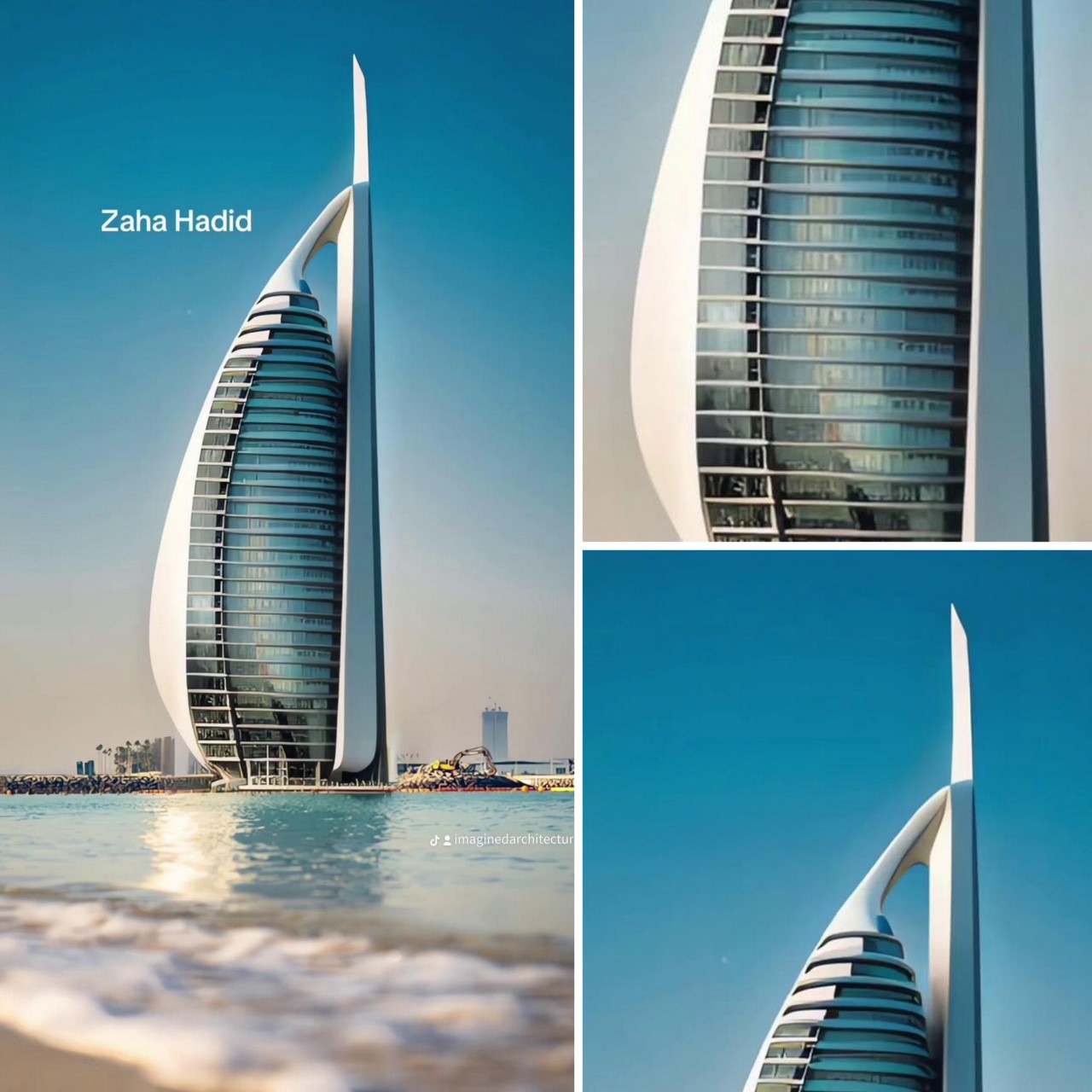
The late Zaha Hadid, a visionary architect known for her radical deconstructivist designs, left an indelible mark on contemporary architecture with her dynamic and innovative approach. Her style was characterized by sweeping fluid forms, often resembling waves or wings, that defy conventional architectural norms. Hadid’s buildings are frequently described as futuristic, emphasizing movement and complexity with an eloquent yet powerful use of curvilinear geometries.
This conceptual rendition of the Burj Al Arab reimagined by Zaha Hadid captures her essence perfectly. The building’s iconic sail-like structure has been transformed into a sinuous form that seems to flow and twist upwards, looking more fluid than the original and harking to the fabric nature of a boat sail. Hadid’s signature style of fluidity is present in the smooth, uninterrupted lines that wrap around the building’s facade, giving the impression of a structure in motion. The blend of glass and white elements pays homage to her frequent use of stark contrasts and reflective surfaces, which create a dynamic interplay with the surrounding environment. This interpretation of the Burj Al Arab retains the original’s bold statement of luxury while infusing it with Hadid’s distinctive futuristic language, suggesting a seamless merge of form and function in a way only she could envision.
3. Le Corbusier
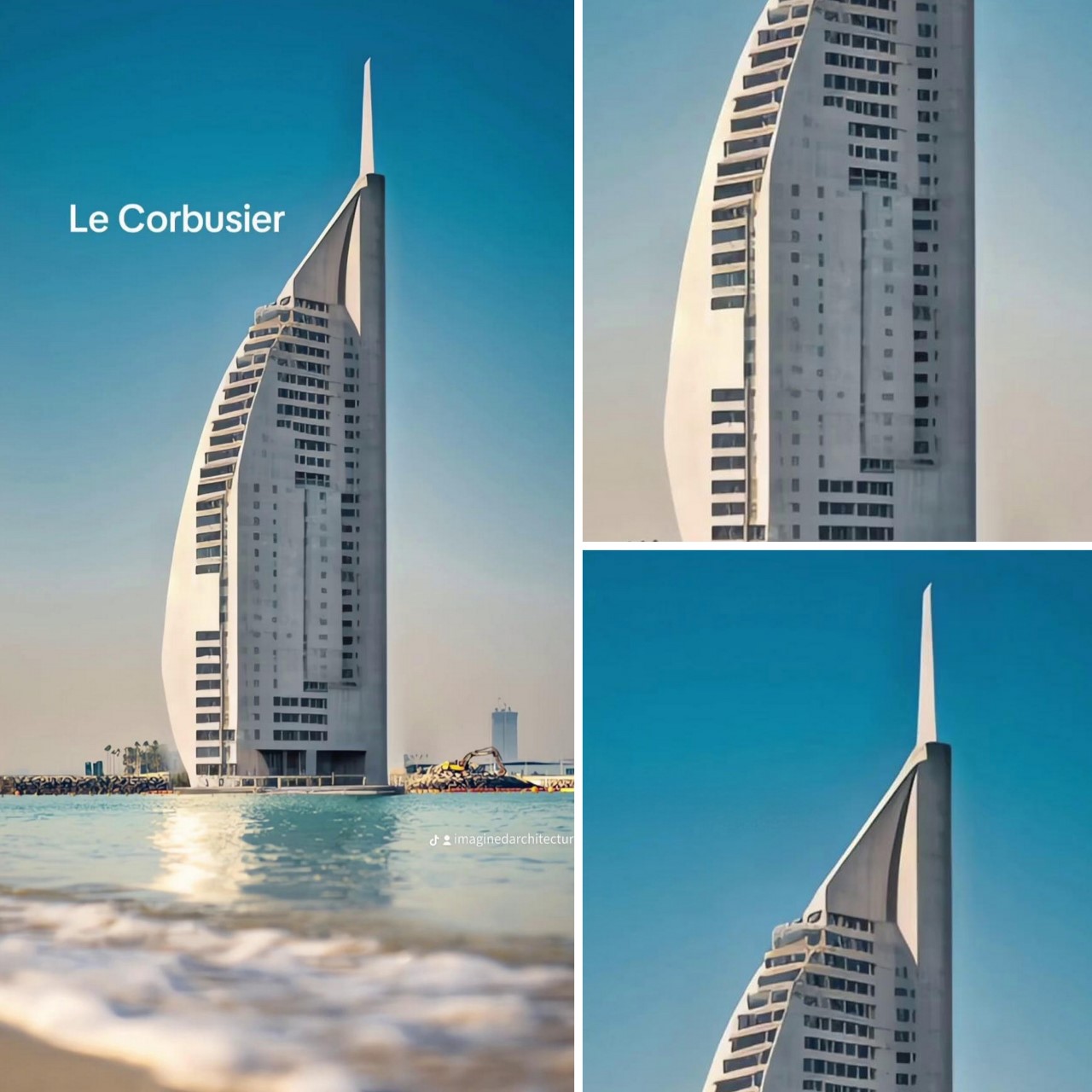
One of the most visionary pioneers of modern architecture, Le Corbusier (born Charles Edouard Jeanneret-Gris) was renowned for his belief in the house as a “machine for living,” favoring functionality and a stark aesthetic that emphasized plain surfaces and the use of materials such as steel and reinforced concrete. His designs often featured an open floor plan, pilotis (supportive columns), horizontal windows, and roof gardens, all elements that signified a break from traditional architectural designs and a step towards a new, modernist ethos.
The image presents a striking interpretation of the Burj Al Arab, as if reimagined through Le Corbusier’s vision. The iconic sail-like structure of the building maintains its sweeping curvature, a bold departure from Le Corbusier’s penchant for rigid geometric forms. However, the influence of Le Corbusier is discernible in the stark white facade, a hallmark of his palette, which speaks to his minimalist approach. This hybrid design could be seen as a nod to both the building’s symbolic status and Le Corbusier’s principles, blending the luxury and symbolism of the Burj Al Arab with the functionalism and simplicity characteristic of Le Corbusier’s work.
4. Oscar Niemeyer
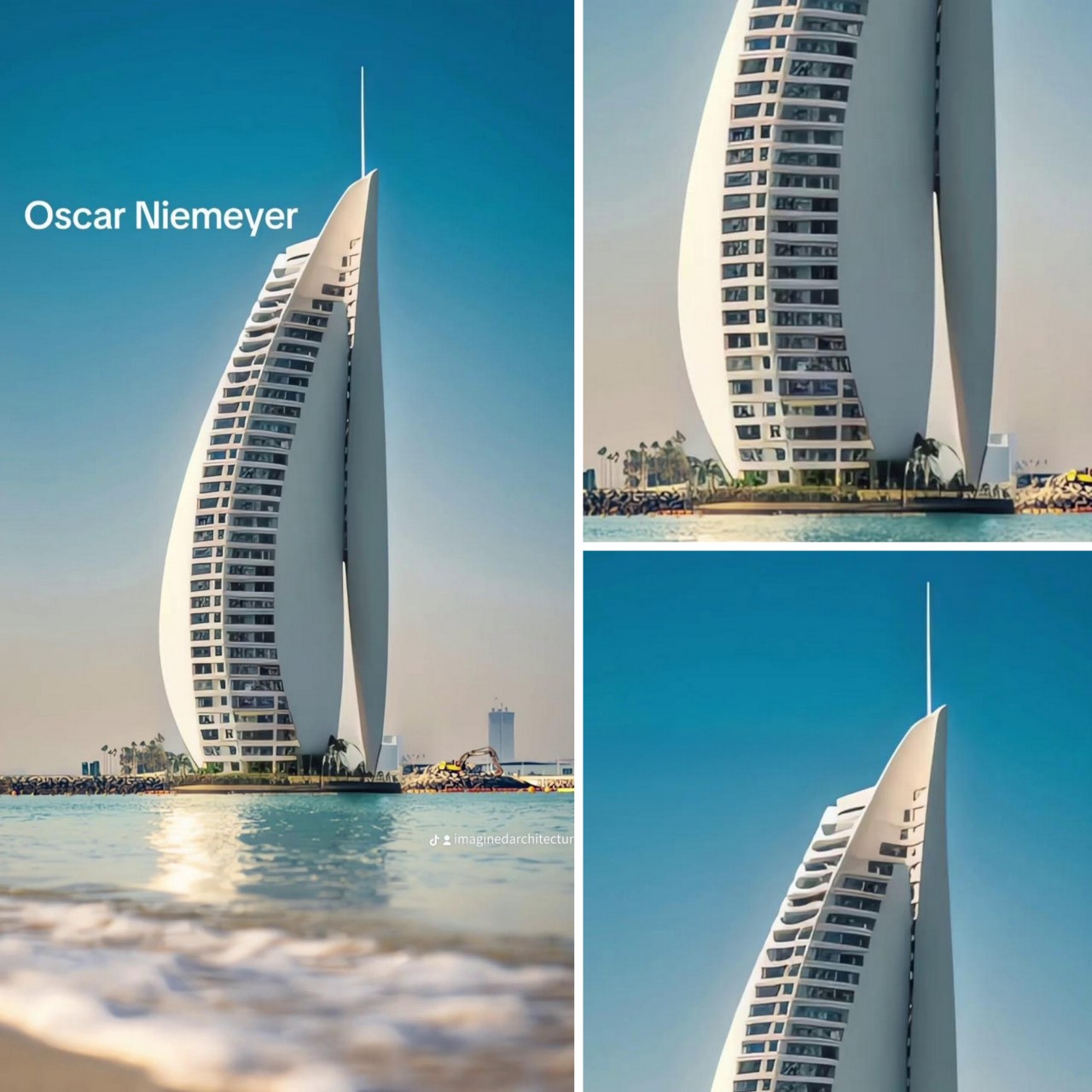
Oscar Niemeyer was a celebrated Brazilian architect who loved to use curves in his designs, often drawing inspiration from the beauty of nature. He was famous for using concrete to create bold, fluid shapes that made his buildings look smooth and organic, much like the curves of a wave or a hill.
Looking at the Burj Al Arab imagined by Niemeyer, we see this love for curves come to life. The building sweeps up into the sky with a graceful bend, like a wave that’s reaching for the clouds. It’s painted in a crisp white, standing out against the blue sky, a favorite approach of Niemeyer to make his designs pop. The curves seem to play with the light and the building almost looks like it’s moving, capturing the essence of the ocean it overlooks. The windows and balconies interrupt the curves just enough to draw your eye without disrupting the overall flow. This version of the Burj Al Arab combines Niemeyer’s vision of blending architecture with nature, creating a structure that’s both a piece of art and a part of the landscape.
5. Walter Gropius
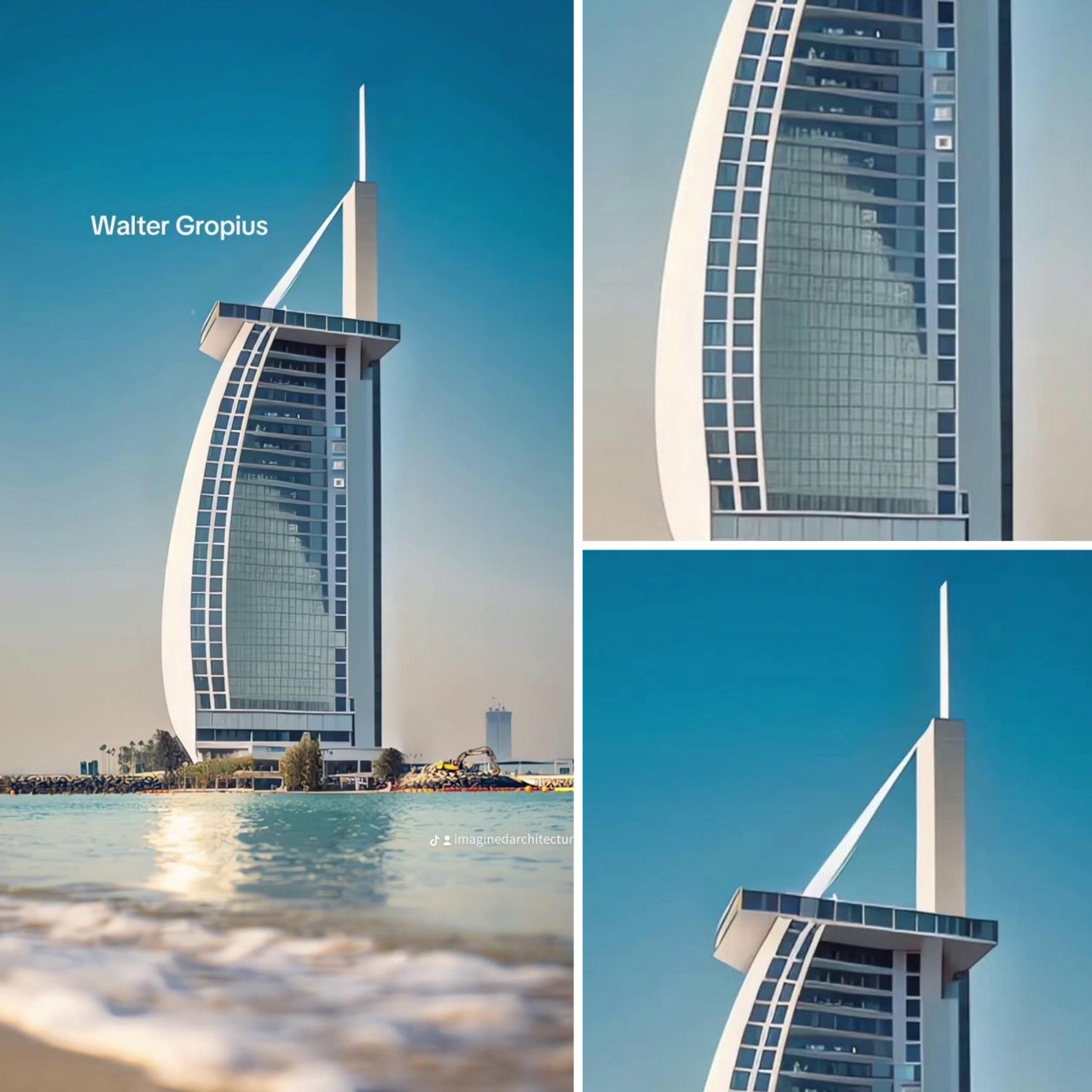
A trailblazer in modern architecture and one of the biggest proponents of the Bauhaus movement, Walter Gropius emphasized simplicity, rationality, and functionality in design. His architectural philosophy was rooted in the absence of ornament, the use of industrial materials, and the integration of technology and art. Gropius’s style often featured clean lines, glass facades, and an aesthetic that underscored the purpose of each building.
In this creative interpretation of the Burj Al Arab as designed by Gropius, we see the hotel’s silhouette simplified. The sail-like form is reimagined with a cleaner, more geometric shape, embodying Gropius’s less-is-more approach. The facade showcases large, unadorned glass panels that invite natural light, a nod to Gropius’s use of transparency to dissolve boundaries between interior and exterior spaces. While the original structure’s exuberance is toned down, this design retains a sense of elegance through its unembellished form and clear lines. It speaks to Gropius’s belief in the beauty of function and the potential of modern materials to redefine luxury. This conceptual Burj Al Arab marries the building’s iconic status with the Bauhaus ideals of simplicity and practical beauty, transforming it into a beacon of modernist design.
6. Frank Lloyd Wright
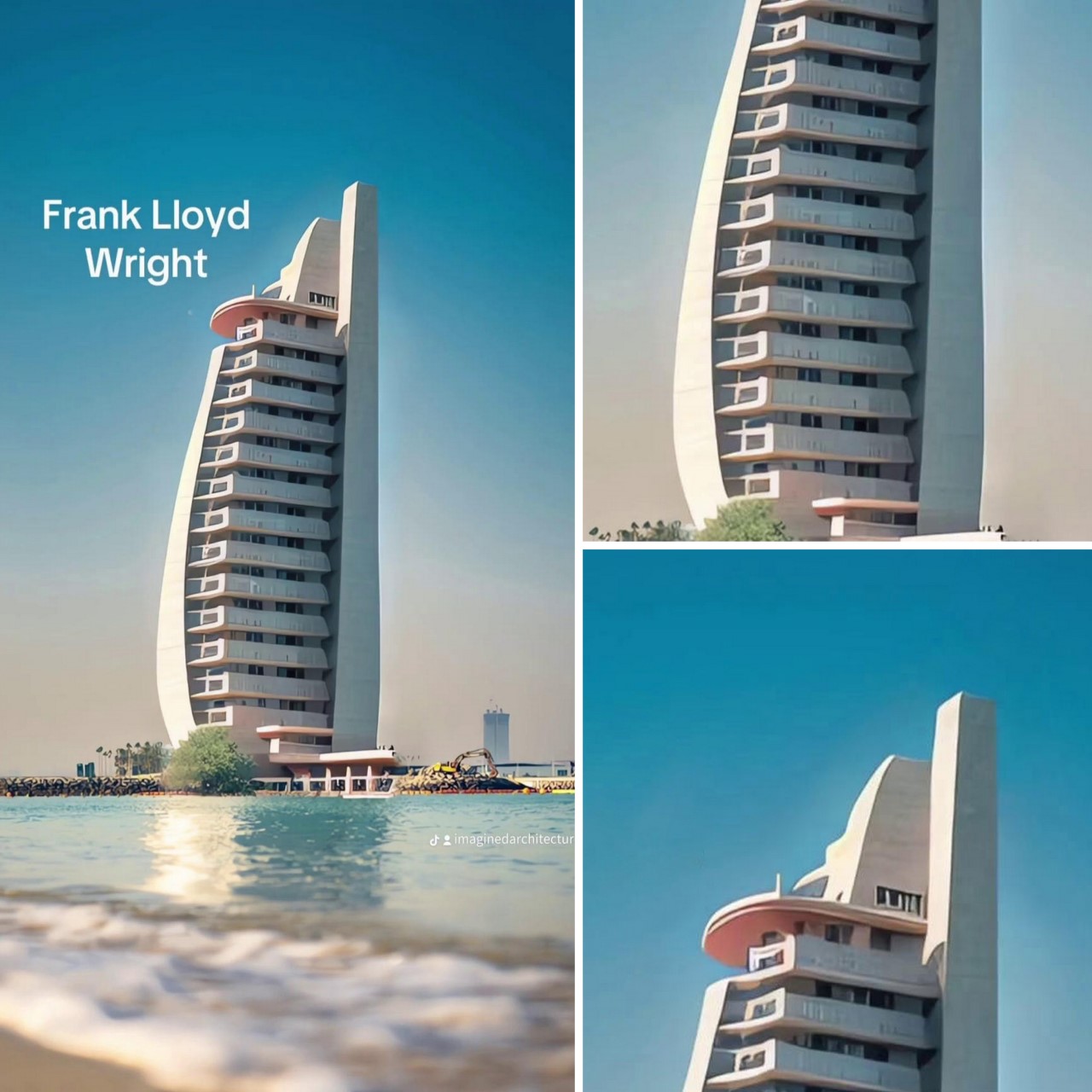
With over 1000 structures and a 70-year career under his belt, Frank Lloyd Wright’s legacy precedes him. Wright was an iconic American architect whose designs were groundbreaking for their integration with the natural environment and their organic architecture philosophy. He believed in designing structures that were in harmony with humanity and their surroundings. Wright’s work often featured strong horizontal lines, overhanging eaves, a central hearth, and a deep connection with the landscape, all meant to promote a sense of calm and organic simplicity.
In the image, the Burj Al Arab reenvisioned by Wright maintains its towering presence but adopts a more pronounced integration with its environment. The building’s profile, while still sleek and soaring, includes Wright’s signature horizontal lines that echo the horizon where sea meets sky. The tiers of the building resemble the stratified layers of earth, a subtle nod to Wright’s practice of drawing inspiration from the land. The terraces and balconies extend outward, reminiscent of Wright’s overhanging eaves, suggesting shelter and openness simultaneously. The organic architecture of Wright is reflected in the building’s gentle curvature, which seems to rise naturally, like a formation shaped by wind and water rather than by humans. This conceptual design marries Wright’s philosophy with modern luxury, offering a unique interpretation of the Burj Al Arab as a serene yet grandiose dwelling place in harmony with the vast seascape.
7. Antoni Gaudi
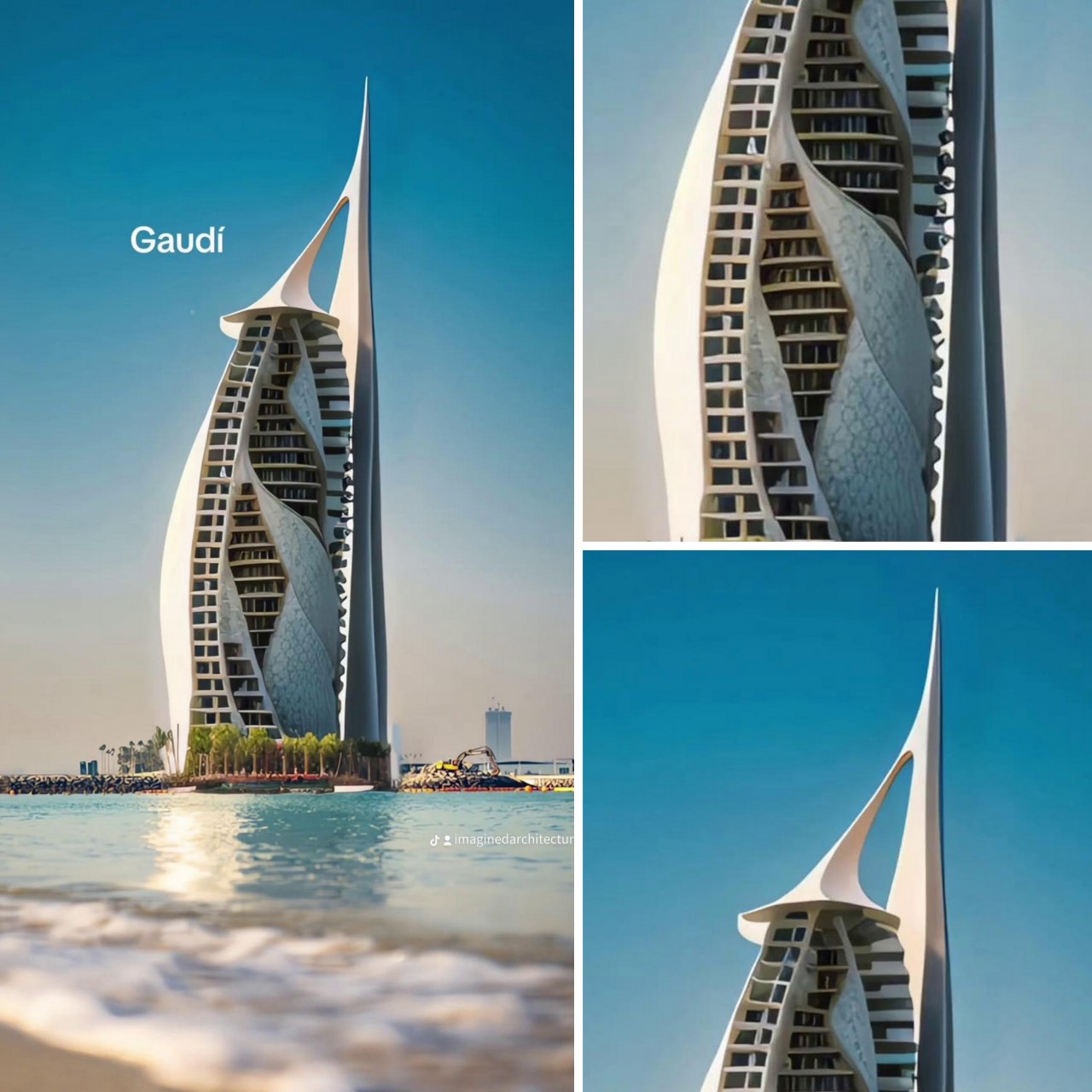
Renowned Spanish architect, Antoni Gaudi left an indelible mark on the world of architecture through his profound connection to the Catalan Modernisme movement. Gaudí’s architectural masterpieces are celebrated for their vibrant hues, rich textures, and organic designs inspired by the beauty of nature. His creations frequently feature the incorporation of mosaic tiles, intricately twisted iron sculptures, and innovative, sinuous stonework, boldly departing from conventional lines and forms.
The image of the Burj Al Arab reimagined by Gaudí shows a playful and imaginative twist on the iconic structure. The hotel’s sail-like facade is transformed with Gaudí’s distinctive style – it features the whimsical curves and organic motifs that are signature to his work. The incorporation of intricate patterns and textures adds depth and a tactile quality that invites close inspection, a stark contrast to the building’s original smooth facade. The use of white for the exterior is a modern touch that aligns with Gaudí’s love for light and reflection, which often played a significant role in his creations. This conceptual design brings together the elegance of the Burj Al Arab with the fantastical and nature-inspired elements of Gaudí’s work, resulting in a building that could be both a functional hotel and a piece of living art.
8. Tadao Ando
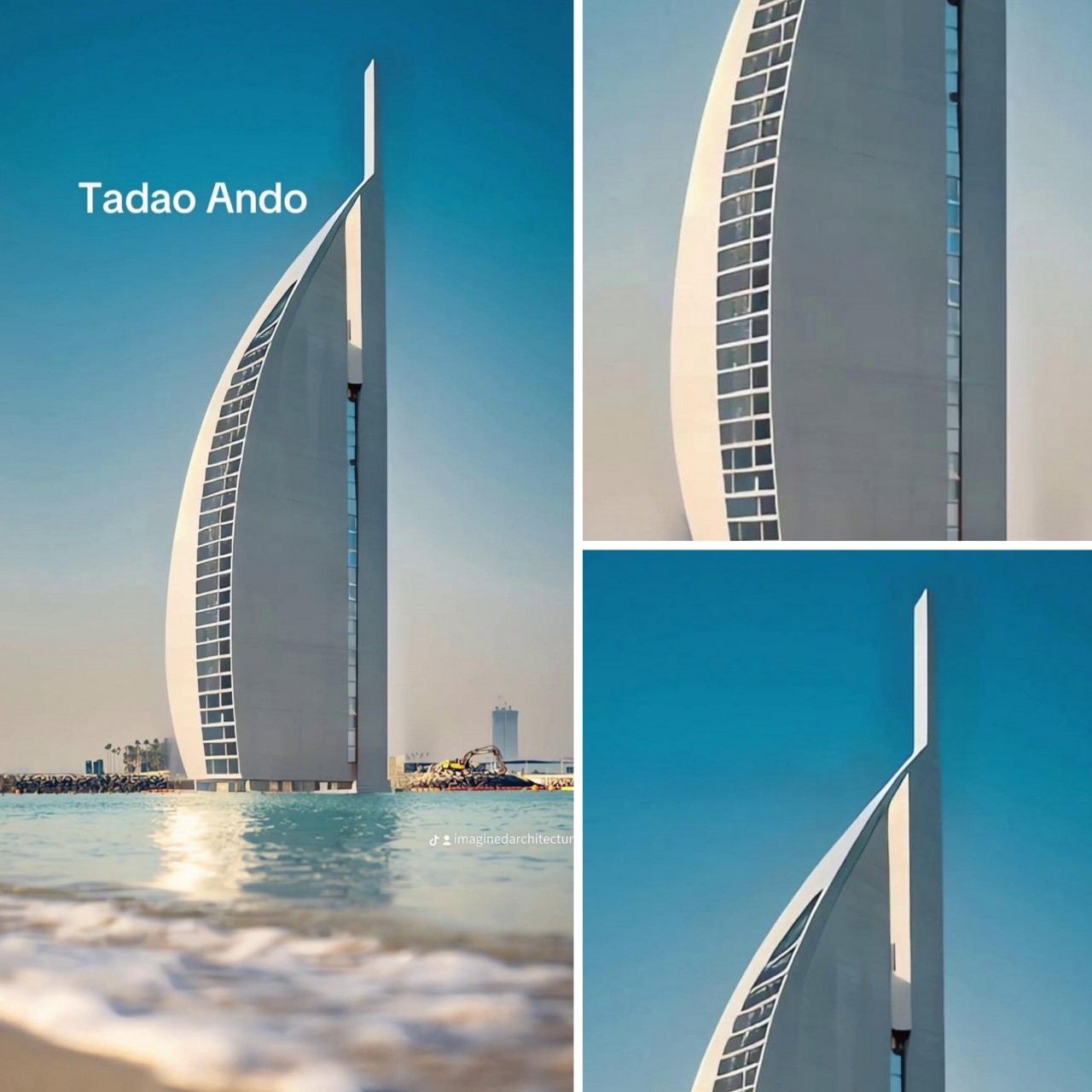
Tadao Ando, a self-taught Japanese architect, is celebrated for his minimalist designs that blend physical and metaphysical elements. His work is distinguished by the creative use of natural light and the incorporation of natural elements into his structures. Ando’s buildings often feature clean lines, large expanses of unadorned concrete walls, and elements of water, which harmonize the structures with their surroundings.
The image illustrates the Burj Al Arab as envisioned by Ando. It reflects his minimalist approach, stripping away the original structure’s ornateness to reveal clean, unembellished surfaces. The stark white facade, a departure from Ando’s characteristic concrete, still conveys his preference for simplicity and geometric clarity. The building’s sweeping form is accentuated by the strategic placement of windows that allow for a play of light and shadow, a tribute to Ando’s mastery of illumination. The result is a unique reinterpretation of the Burj Al Arab that mirrors Ando’s ethos of serene simplicity and thoughtful integration with the environment, culminating in an architectural statement that is both contemplative and bold.
9. Bjarke Ingels
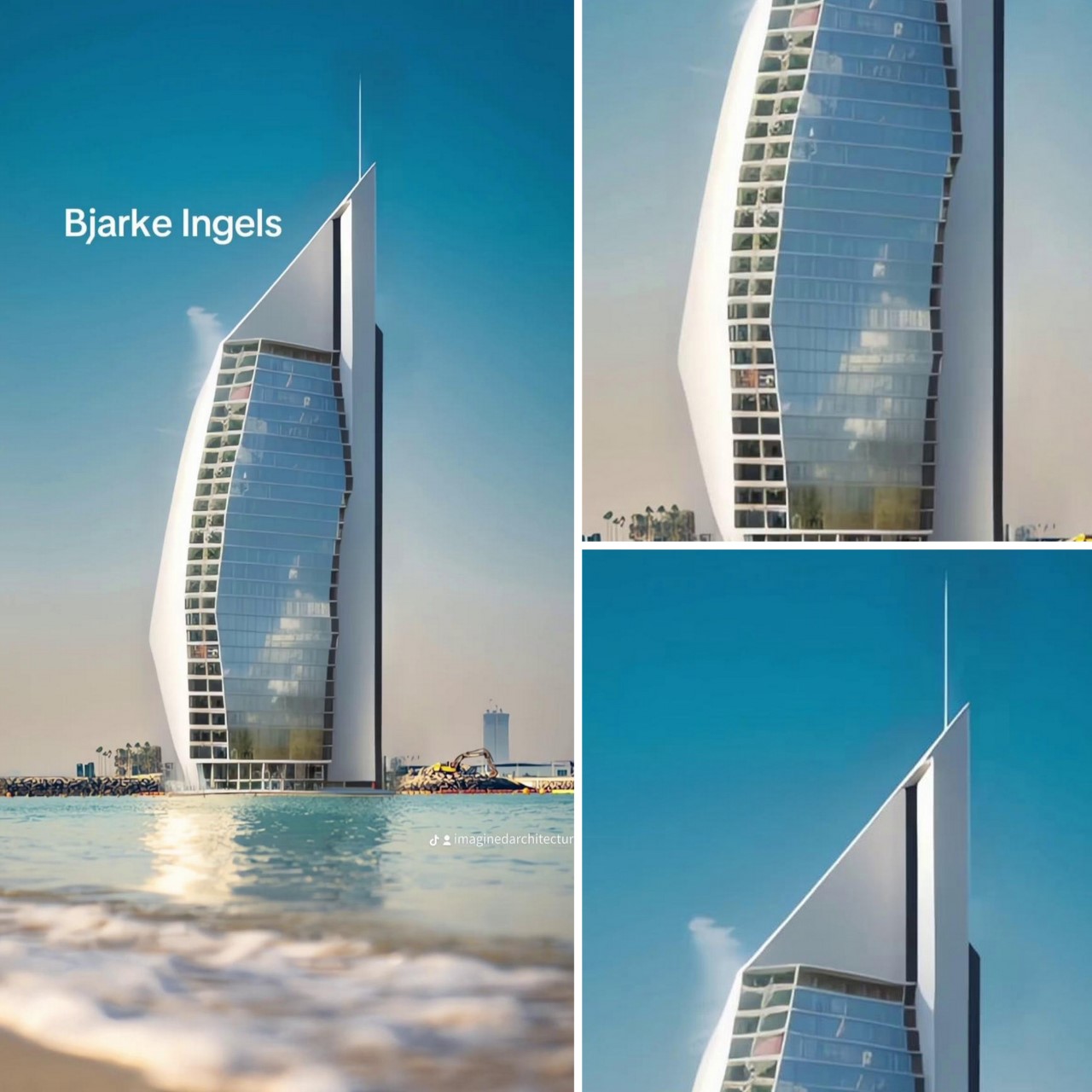
Bjarke Ingels, the founder of BIG (Bjarke Ingels Group), is acclaimed for his architecture that challenges convention with a focus on sustainability and sociability. His notable works, like the Mountain residences in Copenhagen and VIA 57 West in New York, merge functionality with a unique aesthetic that often incorporates elements of nature and futuristic design.
This AI-generated image reinvents the Burj Al Arab through Ingels’ lens, transforming the building into a structure that speaks to modernity and playfulness. The building’s form is mildly undulating, with a lean that suggests movement and a sense of whimsy. This is aligned with Ingels’ preference for architecture that surprises and delights. The façade includes large glass windows, maximizing natural light and offering expansive views, a common feature in Ingels’ designs to bring the outdoors in. The sleek white exterior and clean lines maintain the luxury feel of the original structure but with a modern twist that’s both striking and playful. The overall design captures a balance between the building’s iconic status and the innovative, people-focused approach that Ingels is celebrated for, creating an inviting and sustainable architectural landmark.
10. Jeanne Gang
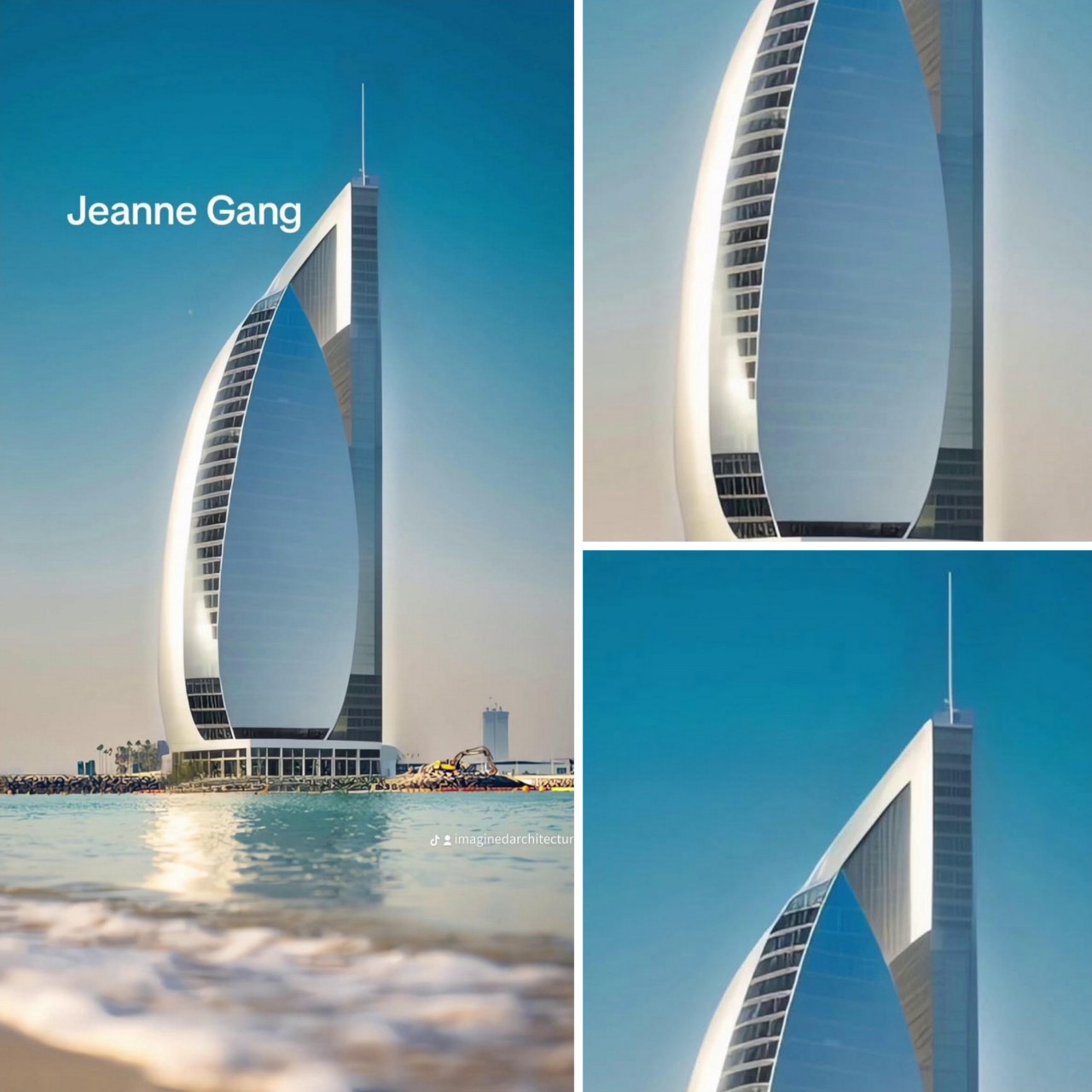
Jeanne Gang, the founding principal of Studio Gang, is renowned for her innovative approach that interweaves architecture with ecological and social issues. Her work often emphasizes sustainability and community, with projects like Aqua Tower in Chicago showcasing her use of distinctive organic forms and responsive design that creates a dialogue with the environment.
The image envisions the Burj Al Arab with the architectural sensibilities of Jeanne Gang. It embodies a sleek elegance while adopting new, flowing lines that suggest a seamless connection with the surrounding seascape. The building’s form appears more integrated with its environment, reflecting Gang’s commitment to creating structures that enhance their settings. The design emphasizes transparency and light, with broad expanses of glass that echo the striated exteriors of Aqua Tower, allowing for natural light to penetrate the building while offering panoramic views. This reimagined Burj Al Arab maintains the iconic silhouette of the original but introduces a fluidity and grace that speaks to Gang’s architectural ethos of harmonizing with nature.



